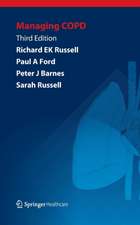Drug-Induced Lung Injury: Respiratory Disease Series: Diagnostic Tools and Disease Managements
Editat de Masayuki Hanaoka, Hiroyuki Nakamura, Kazutetsu Aoshibaen Limba Engleză Hardback – 31 oct 2017
Drug-Induced Lung Injury offers a highly beneficial resource not only for respiratory physicians but also all medical clinicians who prescribe drugs, nurses, pharmacists and pharmaceutical scientists. Written by pioneering experts in the field, the book examines a wealth of cases and the insights they yield concerning the diagnosis, treatment and specific drugs causing the disease. It not only fosters a deeper understanding of the disorder but also highlights the current challenges and paves the way for future clinical research.
| Toate formatele și edițiile | Preț | Express |
|---|---|---|
| Paperback (1) | 645.31 lei 38-44 zile | |
| Springer Nature Singapore – 8 ian 2019 | 645.31 lei 38-44 zile | |
| Hardback (1) | 705.04 lei 22-36 zile | |
| Springer Nature Singapore – 31 oct 2017 | 705.04 lei 22-36 zile |
Preț: 705.04 lei
Preț vechi: 742.15 lei
-5% Nou
Puncte Express: 1058
Preț estimativ în valută:
134.93€ • 140.16$ • 112.08£
134.93€ • 140.16$ • 112.08£
Carte disponibilă
Livrare economică 13-27 ianuarie 25
Preluare comenzi: 021 569.72.76
Specificații
ISBN-13: 9789811044656
ISBN-10: 9811044651
Pagini: 204
Ilustrații: VIII, 215 p. 53 illus., 15 illus. in color.
Dimensiuni: 155 x 235 mm
Greutate: 0.51 kg
Ediția:1st ed. 2018
Editura: Springer Nature Singapore
Colecția Springer
Seria Respiratory Disease Series: Diagnostic Tools and Disease Managements
Locul publicării:Singapore, Singapore
ISBN-10: 9811044651
Pagini: 204
Ilustrații: VIII, 215 p. 53 illus., 15 illus. in color.
Dimensiuni: 155 x 235 mm
Greutate: 0.51 kg
Ediția:1st ed. 2018
Editura: Springer Nature Singapore
Colecția Springer
Seria Respiratory Disease Series: Diagnostic Tools and Disease Managements
Locul publicării:Singapore, Singapore
Cuprins
Part I Definition, Pathogenesis, and Epidemiology.- 1. Definition, Pathogenesis and Epidemiology: What is DLI?.- 2. Epidemiology and Risk Factors of Drug-Induced Lung Disease: What are the prevalence and risk factors of DLI?.- 3. Clinical Characteristics of DLI: What are the clinical features of DLI?.- Part II Diagnosis.- 4. Diagnostic Approach for DLI: How is DLI diagnosed?.- 5. Blood tests for the diagnosis and/or management of DLI: What are the clinical significances of KL-6, SP-A, SP-D and DLST in DLI?.- 6. Imaging features of drug-induced interstitial lung disease: How HRCT of DLI is interpreted?.- 7. Pathology of DLI: What is the pathological significance of DLI?.- 8. Differential Diagnosis of DLI: What are the differential diagnoses of DLI?.- Part II Treatment.- 9. Therapeutic Strategies for DLI: How should DLI be treated?.- Part IV Drugs Causing DLI.- 10. DLI induced by non-molecular target antineoplastic drugs: What are the characteristics of DLI in non-molecular target antineoplastic drugs?.- 11. DLI induced by Molecular Target Antineoplastic Drug: What are the characteristics of DLI in molecular target antineo-plastic drugs?.- 12. DLI caused by disease-modifying antirheumatic drugs: What are the characteristics of DLI by disease-modifying antirheumatic drugs?.- 13. DLI Induced by Herbal Medicine: What are the characteristics of DLI due to herbal medicines?.- 14. DLI induced by Antiarrhythmic Drug and Antimicrobial Drug: What are the characteristics of DLI in antiarrhythmic drugs and antimicrobial drugs?.
Notă biografică
Editors
Masayuki Hanaoka
First Department of Medicine
Shinshu University School of Medicine
Matsumoto, Japan
Hiroyuki Nakamura
Department of Respiratory Medicine
Tokyo Medical University Ibaraki Medical Center
Ibaraki, Japan
Kazutetsu Aoshiba
Department of Respiratory Medicine
Tokyo Medical University Ibaraki Medical Center
Ibaraki, Japan
Masayuki Hanaoka
First Department of Medicine
Shinshu University School of Medicine
Matsumoto, Japan
Hiroyuki Nakamura
Department of Respiratory Medicine
Tokyo Medical University Ibaraki Medical Center
Ibaraki, Japan
Kazutetsu Aoshiba
Department of Respiratory Medicine
Tokyo Medical University Ibaraki Medical Center
Ibaraki, Japan
Caracteristici
Introduces representative drugs causing the disorder such as antineoplastic drugs, biological products, and molecular target drugs Will not only benefit respiratory physicians but all medical clinicians who prescribe drugs, nurses, pharmacists and pharmaceutical scientists Fosters a deeper understanding of the disorder, highlights the current challenges and paves the way for future clinical research














